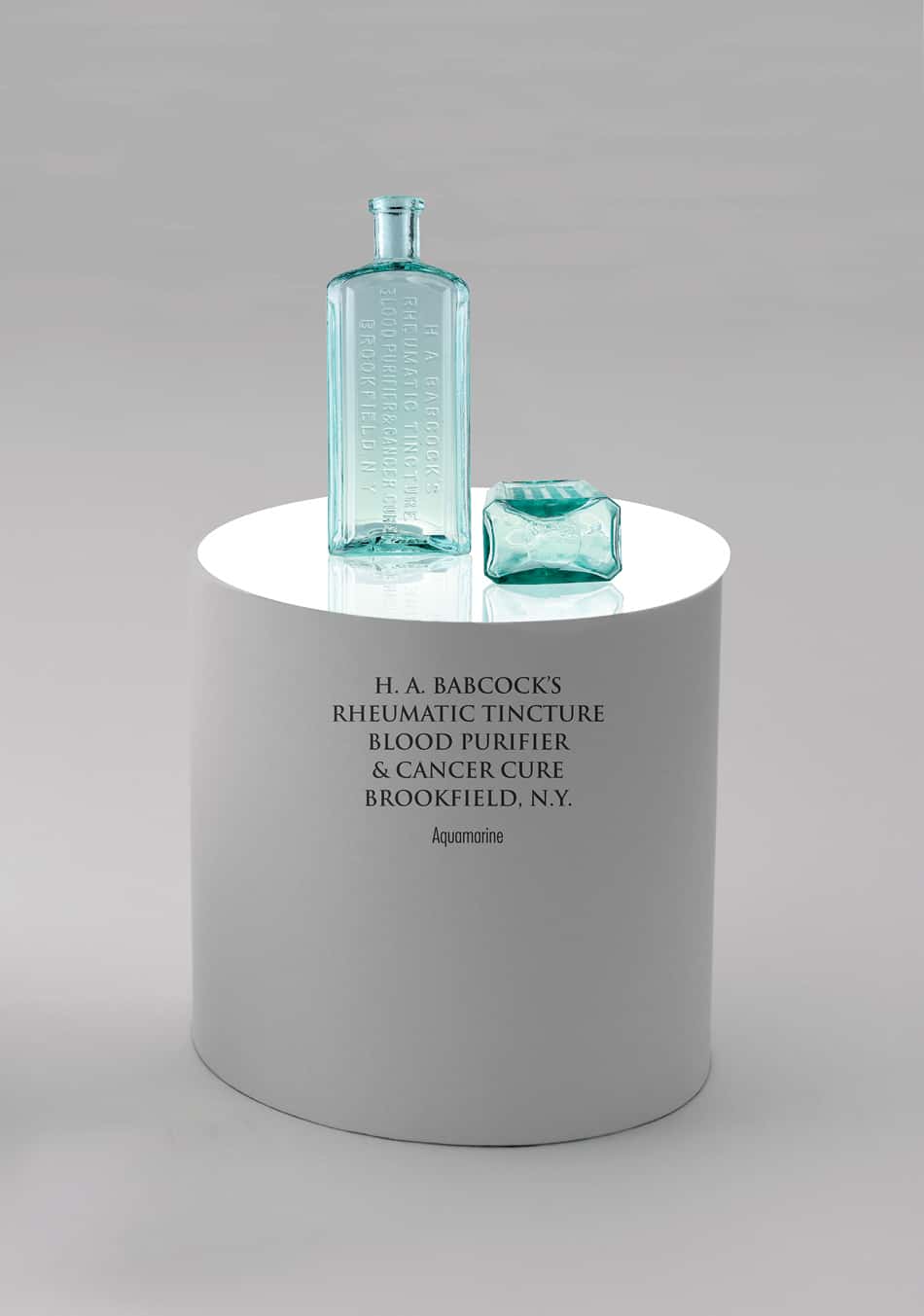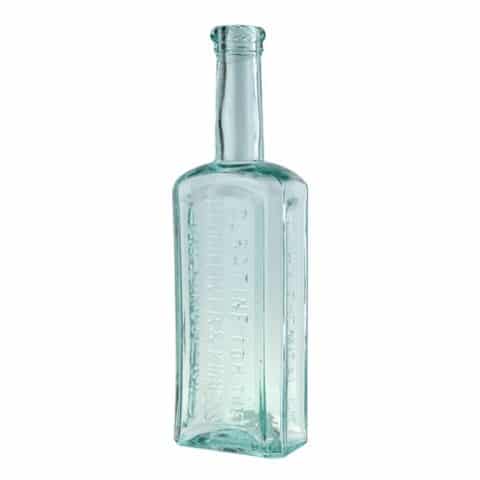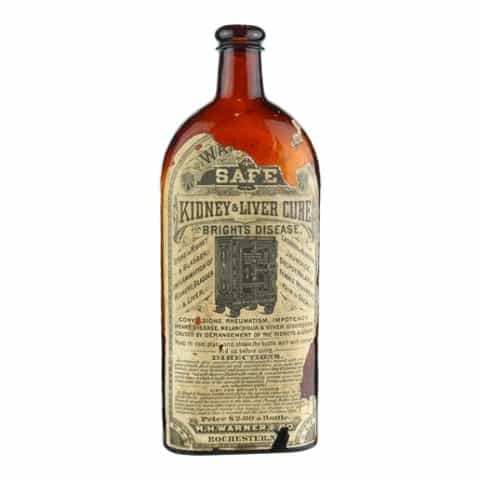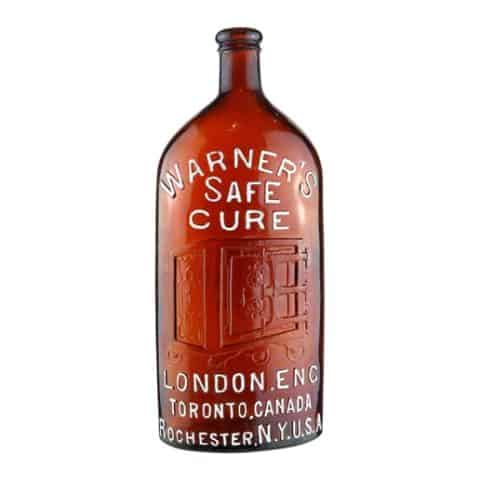H A Babcock’s Rheumatic Tincture Blood Purifier & Cancer Cure Brookfield, N.Y.
H. A. Babcock’s Rheumatic Tincture Blood Purifier & Cancer Cure Brookfield, N.Y.
WT&Co. 2 U.S.A.
Harvey A. Babcock, Brookfield, New York
Aquamarine Cure Bottle
Provenance: Bob Jochums Collection

Despite this rare nostrum being treasured as it is the sole embossed cancer cure dispensed in the United States, advertising was limited and focused on its function as a rheumatic tincture. Harvey A. Babcock’s product originated in his home town where he operated a store that was so well known that newspaper articles and advertisements simply referred to it as “Babcock’s” and only rarely as “Babcock’s Drug Store.”
In the late 19th century, Brookfield, N.Y. had a population of approximately 3,000, and every town within a 25-mile radius, save Utica, N.Y. (population in 1890 of 44,000), was even less populated. Yet Babcock’s product was only marketed and advertised in the smaller towns.

Our extraordinary museum example of this strongly embossed, aquamarine bottle is out of the Kevin Kelly collection. With a nicely tooled and thick square band collar on a straight and fairly short neck, this hefty rectangular bottle with chamfered corners measures 8 ¼ x 3 ¼ x 2 inches. All the embossing is in four lines on an inset beveled panel in a sans serif typestyle reading from top to bottom. The two sides also have indented panels while the remaining wide panel is smooth where a label was applied. The base is embossed ‘WT&Co. 2 U.S.A.’ having been manufactured by Whitall Tatum & Company located in Millville, New Jersey. This particular base embossing was used from 1857 to 1900 which dates this bottle to pre-1900 despite the product being sold until 1914.

Harvey A. Babcock was born in New York in 1844 and by the time he was twenty-six years old, he had settled in Brookfield, New York. His occupation, as noted in three Federal decennial census records (1880, 1890, and 1910) was that of a farmer despite being the proprietor of Babcock’s Drug Store. At the age of just shy of twenty-seven, he had married Eulalie C. Coon (age 17) who bore two children, one of whom (Angelette) died at the age of two while the second daughter (Nellie) outlived her parents. Eulalie died in 1877, one year after the birth of their second daughter Nellie (1876), and after having been married to Babcock for just six years. In 1902, Babcock remarried at the age of fifty-eight. Emma D. Rhoades was also 58 years old and her occupation was also that of a farmer.
Babcock produced several medical products to supplement his Rheumatic Tincture including Harvey A. Babcock’s Soothing Cough Syrup, Babcock’s Eradicator Troches, Babcock’s Healing Ointment, and Babcock’s Catarrh Eradicator.
Some newspaper advertisements recommended combining the use of these products with Babcock’s Rheumatic Tincture to effect a cure.
Babcock’s method of advertising frequently involved the use of testimonials which one never knows whether they were legitimate or fabricated. One such testimonial was about his daughter Nellie at age seven and eight: “… daughter of H. A. Babcock was cured of the worst form of catarrh in 1883 and 1884 by using Babcock’s Eradicator after Doctors and Patent Remedies failed.”
Babcock’s Rheumatic Tincture was advertised from 1884 to 1914 as a “Rheumatic Tincture and Vegetable Blood Purifier. An Indian remedy for the cure of Cancers and Rheumatism. A lasting stimulant, Nervine and Tonic. Alterative, Diuretic, Anodyne and Emmenagogue. The best remedy known for Rheumatism, an excellent remedy for the removal of mercurious, scrofulous, syphilitic and cutaneous diseases. A popular remedy in Fever and Ague and nervous affections.” The cost of this wonder product in the late 1890s was $1 per bottle of 250 doses or $5 for six bottles.
Babcock’s testimonials on the ability of his product to cure cancer were scarce and became even less commonplace as the Federal Government moved into denouncing and restricting fraudulent medical claims just after the turn of the 20th century. The Great American Fraud written by Samuel Hopkins Adams and published in Collier’s Weekly in 1905-1906, spoke of “incurable disease (being) one of the strongholds of the patent medicine business” and “the ideal patron, viewed in the light of profitable business, (being) the victim of some slow and wasting ailmen (sic) in which recurrent hope inspires to repeated experiments with any ‘cure’ that offers.” With the passage of the Federal Pure Food and Drugs Act in 1906, the scientific value of testimonials began to be exposed as “nil” while “as psychic stimulants, they rank high.” – Nostrums and Quackery
Harvey A. Babcock died in 1917 at the age of 72.
Primary Image: Babcock’s Rheumatic Tincture Blood Purifier & Cancer Cure bottle imaged on location by Alan DeMaison, FOHBC Virtual Museum Midwest Studio
Research: Bob Jochums, Berkeley Lake, Georgia
Support: Reference to The Great American Fraud, Samuel Hopkins Adams, Collier’s Weekly, 1905-1906, page 45.
Support: Reference to Nostrums and Quackery, second edition, 1912, The Journal of the American Medical Association, page 683.
Support Image: Paper-labeled example of the embossed “H.A. Babcock’s Rheumatic Tincture Blood Purifier & Cancer Cure Brookfield, N.Y.” bottle. – Jim Hagenbuch, Glass Works Auctions
Join the FOHBC: The Virtual Museum is a project of the Federation of Historical Bottle Collectors (FOHBC). To become a member.































